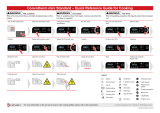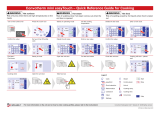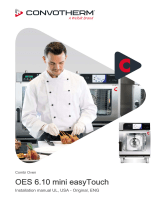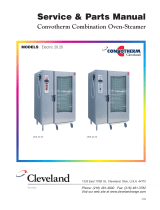Page is loading ...

Combi Oven
OES 10.10 mini
Operating manual UL, USA – Original, ENG


FOR THE INSTALLER, OPERATOR, RESPONSIBLE OWNER
FOR YOUR SAFETY
Do not store or use gasoline or other flammable vapors or liquids in the
vicinity of this or any other unit.
WARNING
Improper installation, adjustment, alteration, service or maintenance can
cause property damage, injury and death. Read the installation, operating
and maintenance instructions thoroughly before installing or servicing this
equipment.
WARNING
To reduce the risk of electric shock, do not remove or open cover.
No user serviceable parts inside. Refer servicing to qualified personnel.
Disconnect power supply before servicing.
WARNING
Disconnect power at the main external power switch before servicing or
repairing a combi oven.
IMPORTANT
ALL SERVICE MUST BE PERFORMED BY A QUALIFIED CONVOTHERM AUTHORIZED TECHNI‐
CIAN.
KEEP AREA FREE AND CLEAR OF COMBUSTIBLES.
Installation
■
Installation of this unit must be done by a licensed professional when installed in the Commonwealth
of Massachusetts.
■
The wiring diagram is located on the inner part of the side panel.
Customer documentation
■
The customer documentation is part of the combi oven.
■
Keep the customer documentation manuals handy at all times so that you can look up any required
information.
■
Keep the customer documentation manuals for the entire life of the unit.
■
Carefully read the installation manual, the operating manual, and the operating instructions before
using, handling, and working on this unit.
■
If you transfer the combi oven to a new owner, make sure to give the new owner the customer doc‐
umentation manuals as well.


Table of Contents
1 General 8
1.1 Environmental Protection 8
1.2 Identifying Your Combi Oven 9
1.3 Customer Documentation Structure 10
1.4 Safety Information That Must Be Read without Exception 11
1.5 About this operating manual 12
2 Configuration and Functions 14
2.1 Basic overview of how the combi oven works 14
2.2 The Combi Oven's Configuration and Functions 15
2.3 Control Panel Layout and Functions 17
3 For Your Safety 18
3.1 Basic Safety Instructions 18
3.2 Your Combi Oven's Intended Use 19
3.3 Warning Labels on the Combi Oven 21
3.4 Overview of Hazards 23
3.5 Hazards and Safety Measures During Operation 25
3.6 Hazards and Safety Measures During Cleaning 30
3.7 Hazards and Safety Measures During Maintenance 36
3.8 Safety Devices 38
3.9 Staff and Work Area Requirements 40
3.10 Personal protective equipment 41
4 Getting Started 42
4.1 Basic Steps for Cooking 42
4.2 Basic Steps for Rethermalization 43
4.3 Turning the Combi Oven On and Off 43
5 Control panel layout 45
5.1 Control Panel Layout 45
5.2 The controls 47
5.3 The Function Menu 49
5.4 The Cookbook Menu 52
5.5 The Write/Edit Menu 53
6 How to Work with the Control Panel 54
6.1 Entering Cooking Data 54
6.1.1 Basics of entering cooking data 54
6.1.2 Setting Up a Cooking Program 55
6.1.3 Setting Up a Rethermalization Program 56
6.1.4 Setting Up a Multi-Step Program 57
6.1.5 Entering a preset start time 58
6.2 Using Extra Functions and Special Programs 60
6.2.1 Basics of selecting extra functions and special programs 60
6.2.2 Setting Up the Crisp&Tasty (Moisture Removal) Function 61
6.2.3 Setting Up the Pre-Heat Function 62
6.2.4 Using Delta-T Cooking 63
6.2.5 Entering Cook&Hold 64
6.2.6 Adding a Buzzer Sound to a Cooking Program 66
Table of Contents
Operating Manual 5

6.2.7 Setting Up Overnight Cooking 67
6.2.8 Activating the Button Lock Function 68
6.3 Using Functions While a Program Is Running 71
6.3.1 Viewing Cooking Parameters While a Program Is Running 71
6.3.2 Changing Cooking Parameters While a Program Is Running 72
6.3.3 Stopping a Program Before It Ends 72
6.4 Working with the Cookbook 73
6.4.1 Accessing a cooking profile in the cookbook 73
6.4.2 Create cooking profile 74
6.4.3 Recording a Cooking Program 76
6.4.4 Adding a cooking profile to the cookbook 78
6.4.5 Editing, deleting and copying cooking profiles 79
6.4.6 Inserting, Appending, and Deleting Cooking Steps 81
6.4.7 Using Press&Go 84
6.5 Configuring Basic Settings 86
6.5.1 Accessing the Basic Settings 86
6.5.2 Setting an acoustic signal 87
6.5.3 Adjusting the Volume 87
6.5.4 Setting the Time 88
6.5.5 Setting the Date 89
6.5.6 Sorting Alphabetically or Numerically 90
6.5.7 Changing Standard Values and Using Memory Values 91
6.5.8 Selecting a Temperature Unit 93
6.5.9 Setting the Network Address 94
6.5.10 Backing Up / Loading the Cookbook 95
6.5.11 Setting a language 96
7 Cooking and Rethermalizing 97
7.1 Safely Using the Unit 97
7.2 Cooking with Press&Go 99
7.3 Day-to-Day Cooking 100
7.4 Day-to-Day Rethermalization 102
7.5 Manual Steaming During Cooking 104
7.6 Using Unoccupied Shelves During Cooking 105
7.7 Using Unoccupied Shelves During Rethermalization 106
8 How to do it right 107
8.1 Safely Using the Unit 107
8.2 Safely Opening and Closing the Unit Door 108
8.3 Placing Food Inside and Taking It Out 109
8.4 Removing and installing racks 111
8.5 Removing and installing the suction panel 113
8.6 Putting Away and Removing the Core Temperature Probe 115
9 Cleaning and maintenance 116
9.1 Cleaning schedule and cleaning agent 116
9.1.1 Cleaning schedule 116
9.1.2 Cleaning agents 118
9.2 Cleaning programs and tasks 120
9.2.1 Working Safely When Cleaning 120
9.2.2 Cleaning a Cold Oven Cavity Semi-Automatically 123
9.2.3 Cleaning a Hot Oven Cavity Semi-Automatically 125
9.2.4 Using the ConvoClean System's Fully Automatic Cleaning Sequence to Clean the
Oven When It Is Cold
127
Table of Contents
Operating Manual 6

9.2.5 Using the ConvoClean System's Fully Automatic Cleaning Sequence to Clean the
Oven When It Is Hot
129
9.2.6 Cleaning the hygienic removable gasket 132
9.2.7 Clean the double-pane door 133
9.2.8 Cleaning the oven cavity behind the suction panel 134
9.2.9 Replacing the cleaning agent canister containing ConvoClean forte 136
9.2.10 Replacing cleaning agent canisters with ConvoCare 137
9.3 Maintenance 138
9.3.1 Maintenance schedule 138
9.3.2 Emergency Mode 139
9.3.3 Troubleshooting – Error Codes 141
9.3.4 Troubleshooting – Problems During Operation 142
9.3.5 Replacing the oven light halogen lamp 144
10 The cooking programs in your combi oven 148
10.1 The Cooking Programs at a Glance 148
10.2 Steaming 149
10.3 Combi-steam 151
10.4 Hot air 152
10.5 Rethermalization 153
10.6 Core temperature measurement 154
10.7 Delta-T cooking 156
10.8 Cook&Hold 158
10.9 Overnight cooking 160
11 Coming Up with Your Own Custom Cooking Profiles 163
11.1 Side dishes 163
11.2 Fish 164
11.3 Meat, poultry, game 165
11.4 Pastries 167
Table of Contents
Operating Manual 7

1 General
Purpose of this section
This section provides information on how to identify your combi oven and how to use this manual.
1.1 Environmental Protection
Policy statement
Our customers' expectations, the legal regulations and standards we have to follow, and our compa‐
ny's reputation are what drives the quality and service behind all our products.
Our environmental management policy is not only designed to ensure that we are always in full com‐
pliance with all environmental laws and regulations, but also reflects our commitment to the environ‐
ment and to continuously improving our performance in this field.
In order to ensure that we meet all of our environmental goals while maintaining the high quality of our
products, and that things stay this way, we have developed a quality and environmental management
system.
This system meets the requirements set forth in ISO 9001:2008 and ISO 14001:2004.
Environmental protection measures
The following measures apply to this product:
■
Uses fully compostable packing products
■
Uses RoHS-compliant products
■
Complies with the REACH regulation
■
Shipping boxes are reused
■
Recommends and uses biodegradable cleaning agents
■
E-waste recycling
■
Environmentally friendly disposal of old units
Join us in our commitment to protecting the environment!
1 General
Operating Manual 8

1.2 Identifying Your Combi Oven
Nameplate location
The nameplate is found on the left side of the combi oven.
Nameplate layout and structure
The nameplate makes it easy to identify your unit. The nameplate has the following layout:
No. Designation
1
Unit name
Combi Oven
2
Trade name
Letters: Meaning:
OES Electrical units with water injec‐
tion
xx.yy numbers Unit size
mini Series
3
Electrical specifications
4
Unit tests
5
Serial number
6
Item number
1 General
Operating Manual 9

1.3 Customer Documentation Structure
Customer documentation parts
The customer documentation for the combi oven is made up of the following:
■
Installation manual
■
Operating manual (this manual)
Customer Documentation Structure
The following table outlines how the customer documentation is structured:
Subject Description Please refer to
Transportation Transporting the combi oven Installation manual
(intended for trained
qualified personnel;
see Staff Require‐
ments)
Setup
■
Setup options
■
Correctly setting up the combi oven
Installation
■
Electrical connection
■
Water connection
■
Installing the ConvoClean fully automatic clean‐
ing system
Placing into operation Combi oven initial startup
Operation
■
User interface explanation
■
Work sequences and steps
Operating manual
(intended for briefed
staff and trained
qualified staff; see
Staff Requirements)
Cleaning
■
Cleaning schedule
■
Cleaning programs and tasks
Maintenance
■
Maintenance Schedule
■
limited maintenance work
Removing from service Removing the combi oven from service Installation manual
Technical data
■
Shelf options
■
max. loading weight
Operating manual
All the technical data for the combi oven Installation manual
Scale drawings, connec‐
tion points
All the scale drawings and connection points for
the combi oven
Installation manual
Checklists Installation checklists
1 General
Operating Manual 10

1.4 Safety Information That Must Be Read without Exception
Safety information found in the documentation for the customer
The most important safety information for the combi oven is essentially found in the installation manual
and operating manual.
The installation manual provides safety information for the transportation, setup, installation, placing-
into-operation, and removal-from-service tasks it describes.
The operating manual provides safety information for the cooking, cleaning, and maintenance tasks it
describes.
When using the operating instructions, the operating manual or installation manual should always be
consulted in order to obtain the relevant safety information. When performing activities that go beyond
simply using the software, the safety information in the operating manual and installation manual must
always be observed.
Parts of this document that must be read without exception
Failure to take the information in this document into account may result in death, injury, or property
damage.
In order to ensure their safety and the safety of others, everyone working with/on the combi oven must
read and understand the following parts of this document before starting any work:
■
The 'For Your Safety' section; please refer to For Your Safety on page 18
■
The sections describing the work that will be carried out
Danger symbol
Danger symbol Meaning
Used to warn of potential injury. Observe all the precautionary state‐
ments following this symbol in order to avoid injury or death.
Precautionary statements
The precautionary statements in this manual are categorized using the following hazard levels:
Hazard level Consequences Likelihood
Death / severe injury (irreversible) Imminent
Death / severe injury (irreversible) Potential
Minor injury (reversible) Potential
NOTICE
Property damage Potential
1 General
Operating Manual 11

1.5 About this operating manual
Purpose
The purpose of this operating manual is to provide everyone working with/on the combi oven with the
information they will need to carry out operation, cleaning, and limited maintenance work safely and
correctly.
Target groups
This operating manual is intended for the following target groups:
Name of target group Tasks
Cook Primarily takes care of organizational tasks, such as:
■
Entering cooking program data
■
Editing existing cooking profiles in the cookbook
■
Coming up with new cooking profiles
■
Configuring the unit's settings
and takes care of all operator tasks as well if necessary.
Operator Actually operates the combi oven, taking care of tasks such as:
■
Putting food into the combi oven
■
Starting the cooking program
■
Taking out the food once it has been cooked
■
Cleaning the combi oven
■
Limited troubleshooting
Operating Manual Outline
The following table describes the contents, the goals, and the target groups for the various sections in
this manual:
Section / sub-section Purpose Target
group
General
■
Helps identify your combi oven
■
Explains how to use this operating manual
Cook
Configuration and Func‐
tions
■
Describes the combi oven's intended use
■
Explains the combi oven's functions and describes where
its components are located
■
Describes the technical data for the shelf options and the
maximum loading weight
Cook
Operator
For Your Safety Describes all the risks and hazards posed by the combi
oven, as well as appropriate instructions on how to prevent
and/or counter them
Read this section very carefully!
Cook
Operator
Getting Started
■
Explains how to turn on the combi oven
■
Provides general instructions for working with the combi
oven
Cook
Control Panel Layout Describes the user interface Cook
Operator
How to Work with the
Control Panel
Provides basic instructions for operating the combi oven us‐
ing the control panel
Cook
Operator
Cooking and Rethermal‐
izing
Provides cooking and rethermalization instructions Operator
How to do it right Provides instructions for the work steps that need to be
used repeatedly when working with the combi oven
Operator
1 General
Operating Manual 12

Section / sub-section Purpose Target
group
Cleaning and mainte‐
nance
■
Includes the cleaning schedule
■
Provides the maintenance schedule where relevant to the
operator
■
Provides cleaning instructions
Cook
Operator
The cooking programs in
your combi oven
Goes over the cooking programs Cook
Coming Up with Your
Own Custom Cooking
Profiles
Describes cooking profiles as examples for coming up with
your own cooking profiles
Cook
Decimal mark used
In order to ensure that all numbers can be properly understood internationally, a decimal point is al‐
ways used.
1 General
Operating Manual 13

2 Configuration and Functions
Purpose of this section
This section describes the combi oven's configuration and explains its functions.
2.1 Basic overview of how the combi oven works
Basic cooking programs
Your combi oven can be used to cook a variety of food. To do this, you can use any of the following
basic cooking programs on the combi oven:
■
Steam
■
Hot air
■
Combi-steam (steam superheated without pressure)
Cooking methods you can use
The basic cooking programs can be used for virtually any existing cooking method.
The cooking methods you can use are listed below:
■
Steaming
■
Braising
■
Low-temperature cooking
■
Blanching
■
Baking
■
Thawing food
■
Poaching
■
Scalloping
■
Overnight cooking
■
Stewing
■
Broiling
■
Delta-T cooking
■
Cooking
■
Cooking au gratin
■
Cook&Hold
■
Roasting
■
Rethermalization
The basics of working with your combi oven
The following are the basic steps involved in using the combi oven:
■
Place food in bakeware or on shelf grills and then in your combi oven.
■
Set up a cooking program or a cooking time and start it.
■
Once the cooking program is done, remove the food, which should be cooked to your liking.
2 Configuration and Functions
Operating Manual 14

2.2 The Combi Oven's Configuration and Functions
Combi oven's configuration
The following figure illustrates the combi oven:
1 2
910
5 7 863 4
11
The combi oven's parts and what they do
Following is a description of what the combi oven's parts do:
No. Designation Function
1
Ventilation port Draws in ambient air in order to remove moisture
2
Air vent Lets steam escape
3
Door handle
■
Used to open and close the unit door
■
Cracked-open position for safely opening the combi oven
■
Coated with an antimicrobial coating featuring silver ions ('hy‐
gienic handle')
4
Unit door Seals the oven cavity
5
Control panel Used to control the combi oven
6
Suction panel Used to distribute heat within the oven
7
Rack Used to hold standard-size bakeware
8
Oven light Illuminates the oven cavity
9
Core temperature probe Used to measure the food's core temperature
10
Oven cavity Is where food is placed while it is being cooked
11
Nameplate Used to identify the combi oven
Shelf options
The following table lists the various shelf options:
Capacity
Qty.
13" x 18" half size sheet pans [pcs] 10
12" x 20" by 2 1/2" steam table pans [pcs] 5
2 Configuration and Functions
Operating Manual 15

Capacity
12" x 20" wire fry baskets [pcs] 6
Plates, max Ø 11" (rethermalization only) [pcs] 12
2/3 US hotel pan [pcs] 5
Only use standard size bakeware (containers, oven racks, and sheet pans) with appropriate dimen‐
sions.
The rack can accommodate a variety of sheet pans, bakeware, and oven racks. The specific ones lis‐
ted above are provided only as an example. In addition, custom rack configurations with customized
loading capacities are available.
Maximum permissible loading weight
The following table lists the maximum permissible loading weight for each combi oven. These values
apply under the condition that the weight loaded onto each shelf does not exceed 11 lbs:
Maximum permissible loading weight
Standard size bakeware (containers, oven
racks, sheet pans)
Per combi oven [lbs] 66
Per shelf [lbs] 11
2 Configuration and Functions
Operating Manual 16

2.3 Control Panel Layout and Functions
Control panel layout
The figure below shows the control panel:
Control panel parts
Following is an explanation of what the control panel's parts do:
No. Designation Function
1
Main switch Used to turn the combi oven on and off
2
Display and program se‐
lection
■
Shows the active cooking program and the selected extra func‐
tions
■
Used to select a basic cooking program or rethermalization pro‐
gram
3
Data input
■
Used to select a cooking parameter so that it can be configured
■
Starts and stops the cooking program
4
Knob Cooking parameters and extra functions can be selected or adjus‐
ted by turning this knob
5
Press&Go buttons Programmable quick-select buttons
2 Configuration and Functions
Operating Manual 17

3 For Your Safety
Purpose of this section
The purpose of this section is to provide you with all the information you will need in order to safely
work with/on the combi oven without putting yourself and others at risk.
Read this section very carefully!
3.1 Basic Safety Instructions
Purpose of these instructions
The purpose of these instructions is to ensure that everyone working with and on the combi oven will
be fully aware of all the risks, hazards, and safety requirements involved and will observe the warnings
in the operating manual and on the combi oven. Failure to follow these instructions may result in
death, injury, or property damage.
Customer documentation manuals
Follow the instructions below:
■
Fully read the 'For Your Safety' section, as well as the section that applies to the way you will be
interacting with the combi oven.
■
Keep the customer documentation manuals handy at all times so that you can look up any required
information.
■
If you transfer the combi oven to a new owner, make sure to give the new owner the customer
documentation manuals as well.
Working with/on the combi oven
Follow the instructions below:
■
Only people who meet all the requirements specified in this operating manual should be allowed to
use and otherwise work with/on the combi oven.
■
Only use the combi oven for its intended use as described in this manual. Never, under any circum‐
stance, use the combi oven for other purposes, even if they seem obvious.
■
Observe all the safety measures specified in this operating manual and on the combi oven. This
applies especially to wearing the required personal protective equipment.
■
Make sure to always stay in the specified work areas when working with/on the combi oven.
■
Do not make any alterations to the combi oven. This includes removing components and adding
components that have not been expressly approved. Above all, however, make sure not to disable
any safety devices or guards.
For more information...
Related subjects
Your Combi Oven's Intended Use 19
Warning Labels on the Combi Oven 21
Overview of Hazards 23
Hazards and Safety Measures During Operation 25
Hazards and Safety Measures During Cleaning 30
Hazards and Safety Measures During Maintenance 36
Safety Devices 38
Staff and Work Area Requirements 40
3 For Your Safety
Operating Manual 18

3.2 Your Combi Oven's Intended Use
The combi oven's intended use
■
The combi oven has been designed and built exclusively for cooking a variety of food in standard-
size bakeware (steam table pans, sheet pans, etc.). Steam, convection, and combi-steam (steam
superheated without pressure) are used for this purpose.
■
The bakeware can be made of stainless steel, ceramic, plastic, aluminum, enameled steel, or
glass. Glass bakeware must not be damaged.
■
The combi oven is intended exclusively for professional commercial use.
Ventilation
The combi oven is a commercial combination oven with integral systems for limiting the emission of
grease laden air.
This unit is UL category KNLZ listed for ventless operation. Allows operators to expand into new non-
traditional outlets. Local codes prevail as stated in NFPA 96-1994 regulations.
Limitations on use
The combi oven should not be used to heat up the following materials:
■
Dry powders or granular products
■
Readily flammable substances or objects with a flashpoint lower than 518°F, such as readily flam‐
mable oils, fats, and plastics
■
Food in sealed cans
Staff requirements
■
The combi oven must be operated exclusively by staff meeting the specified requirements. For the
corresponding training and qualifications requirements, please refer to 'Staff and Work Area Re‐
quirements' on page 40.
■
All staff must be familiar with the risks, hazards, and rules involved in handling heavy loads.
Requirements concerning the combi oven's functional capability
■
Do not operate the combi oven unless it has been properly transported, set up, installed, and
placed into operation as indicated in the installation manual and the person responsible for placing
it into operation has confirmed this.
■
The combi oven should only be used if all safety devices and guards are present, working properly,
and correctly locked in place.
■
All manufacturer specifications concerning how to run and service the combi oven must be ob‐
served.
■
The load placed inside the combi oven must never exceed the maximum permissible loading
weight; please refer to 'The combi oven's configuration and functions on page 15'.
Requirements concerning the combi oven's surroundings
Required combi oven surroundings
■
Ambient temperature between 40°F and 95°F
■
No toxic or potentially explosive atmospheres
■
Do not use or store gasoline or other flammable vapors, gases, or liquids in the vicinity of a combi
oven
■
Dry kitchen floor in order to reduce the risk of accidents occurring
Required installation location characteristics
■
NO fire alarms or sprinkler system directly above the unit
■
NO flammable materials, gases, or liquids above, on, under, or close to the unit
Limitations on use
■
When used outdoors, the unit must be protected from rain and wind
■
Do NOT shift or move the unit during operation
3 For Your Safety
Operating Manual 19

Prerequisites for cleaning
■
Only use the cleaning agents approved by the manufacturer.
■
Do NOT use a pressure washer to clean the unit.
■
Do NOT use a water jet to clean the outside of the unit. Do not use a water jet for anything other
than cleaning the oven cavity.
■
Do NOT use bases or acids to clean the combi oven and make sure it is not exposed to acid
fumes. The only exception is when the oven cavity and the boiler are descaled by an authorized
service company following the manufacturer's instructions.
3 For Your Safety
Operating Manual 20
/











